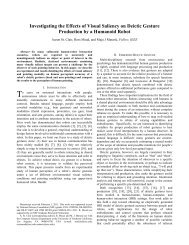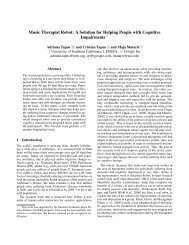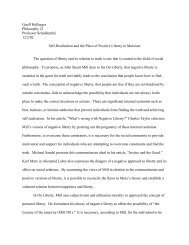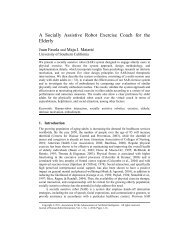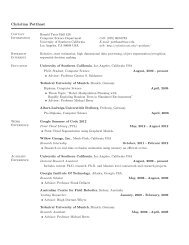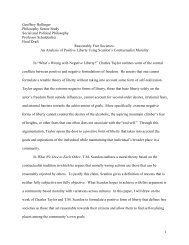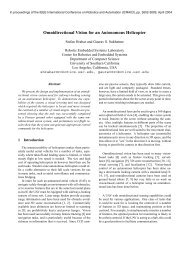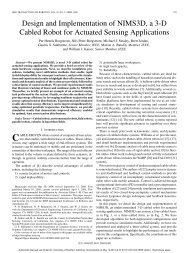Motion Generation for Humanoid Robots with ... - Brown University
Motion Generation for Humanoid Robots with ... - Brown University
Motion Generation for Humanoid Robots with ... - Brown University
You also want an ePaper? Increase the reach of your titles
YUMPU automatically turns print PDFs into web optimized ePapers that Google loves.
[16] in that each behavior is defined by a set of exemplarmotions that are generalized through interpolation.The behavior derivation method (described in depthin [8]) consists of four main components. The derivationsystem takes as input a single continuous kinematicmotion as a time-series of joint angle values. This motionis segmented into intervals based on some heuristicdefining separating events, <strong>with</strong> each segment assumed tobe an atomic motion. Several methods exist <strong>for</strong>segmenting time-series data. We use Kinematic CentroidSegmentation [8], which treats each limb as a pendulumand greedily seeks “swing” boundaries. Segmentation<strong>with</strong> time normalization produces an ordered set of datapoints in a D*N dimensional space, where D is the numberof DOFs and N is the number of frames in each motionsegment. Spatio-temporal Isomap works by findingcommon temporal neighbors (CTN), pairs of points <strong>with</strong>small spatial distances whose sequential neighbors alsohave small spatial distances. Through transitivity, CTNs<strong>for</strong> CTN connected components that result in easilydistinguishable clusters in the produced embedding.Furthermore, the number of clusters is found automaticallyusing no a priori cardinality estimate. Each cluster, calleda primitive feature group, is a set of exemplars <strong>with</strong> acommon spatio-temporal theme that is indicative of someunderlying behavior. Interpolation is used <strong>with</strong>in acluster's set of exemplars to sample new motions from theunderlying primitive behavior. By densely samplingcluster exemplars, each primitive behavior is uncovered asa set of motion trajectories that <strong>for</strong>m a low-dimensionalflow field manifold in joint angle space. Additionally,further embedding/clustering iterations can be applied tosuccessive embeddings <strong>for</strong> clustering higher-level metalevelbehaviors as sequential transition models ofprimitive behaviors. The result from the derivationprocess is a behavior vocabulary consisting of primitivebehaviors, which represent a family of kinematic motionacross a span of variations, and meta-level behaviors,which represent sequential combinations of the primitivesand index into them to produce motion [8].4 Role of Behaviors in ProceduralMemoryIn our approach, the derived vocabulary is assumedto be an intrinsic substrate of basic robot skills.Consequently, this vocabulary is stored as long-termmemory, more specifically as Procedural Memory (PM)(Figure 3). Generally, PM is a memory unit <strong>for</strong> storing askill and procedure and is involved in tasks such asremembering how to reach to a point [3].Each behavior in the vocabulary is stored as a PMunit. Each primitive behavior is stored as a set oftrajectories in joint angle space <strong>with</strong> an indexing structurestored as a PM unit. This indexing structure stores theinitial and final Cartesian coordinates <strong>for</strong> all armtrajectories in a primitive behavior.The Central Executive Controller (CEC) uses the PMindex to search the desired initial and final position ofmotion. It uses the PM units to translate robot goals intocontrol commands <strong>for</strong> accomplishing the goal bysearching <strong>for</strong> PM units suitable <strong>for</strong> accomplishing goalsand then uses the indexing structure of the PM units toproduce the desired motion. For example, if the robot hasthe goal of “reach-to XYZ”, the CEC can determine thatPM “reach” at coordinates “XYZ” will accomplish thisgoal. In a sense, the goal “reach-to XYZ” spawns theintention to “reach, XYZ”, and this intention directlyspecifies which action to take.Figure 3. Structure of the LTM database5 Generating <strong>Motion</strong> from StoredBehaviorsISAC can react to the environmental changesautonomously by generating desired motions from thestored behaviors. The behaviors stored in the PM aremanaged by a central planner, which per<strong>for</strong>ms searchingacross behaviors and <strong>with</strong>in each behavior. Generatingnew motions from the generic behaviors involves aplanning algorithm and an interpolation method.The search mechanism in the CEC receives anestimate of the current external state of the environmentfrom the Sensory EgoSphere (SES) to determineappropriate task-level intentions <strong>for</strong> the robot. Based onthese, CEC uses two-step tasks to search the LTM toprovide control commands to accomplish the robot'sintentions (Figure 4). As mentioned above, PM units storeprimitive behavior motion data as a dense sampling ofmotion trajectories representing the span of variations of abehavior. In the case of a match, the motion trajectory issent to the CEC. If there is no match, a new motion isinterpolated using the local neighbor motions from the
primitive behavior database. Shepard’s interpolation [17]is used. The generated motion data are sent back to theplanner. The actions are then sequenced and sent to thehardware controller(s) to accomplish the robot's intentions.Figure 6: Embedding and clustering of first motion streamusing spatio-temporal Isomap. Lines show temporallyadjacent segments.100 random coordinates <strong>with</strong> the bounding boxmethod were interpolated to obtain new joint spacetrajectories <strong>for</strong> each primitive behavior [17]. The reachingbehavior and return to home behavior are interpolated(Figure 7).Figure 4. Structure of the search mechanism <strong>for</strong> generatingnew motions from stored behaviors.6 Validation6.1 ExperimentISAC is driven by a human operator to reach to 5random points (A, B, C, D, E) on a table, a limitedworking space, as shown in Figure 5.Figure 5: ISAC is taught to reach 5 points on a tableThe motion data stream consisted of 1241 frames,which contained only one reaching behavior. The streamwas segmented using the Kinematic Centroid Method [8]resulting in 10 segments. Each segment was normalizedto 100 frames. The parameters <strong>for</strong> the K-nearestneighborhood, common-temporal (c ctn ) and adjacenttemporal neighborhood (c atn ) constants <strong>for</strong> spatio-temporalIsomap were selected (*). The structure was embedded to3 dimensions. The segments that were similar came closerafter applying spatio-temporal Isomap (Figure 6; eachsegment in the embedding is numbered). The primitivefeature groups were produced through clustering. Thecloser segments were clustered in the embedded space<strong>with</strong>in 0.1 of the diagonal of the embedding bounding boxto derive the primitive behaviors [4]. The clusteringresulted in two derived primitive behaviors: reaching andreturning to home positions.(*) K –nearest neighbors = 3, c ctn =100 and c atn = 1.Figure 7: Results from interpolating selected action units.Each plot shows trajectories in Cartesian coordinates.(Left) reaching, (Right) returning to home.Spatio-temporal Isomap was applied a second time(**). Sweep-and-prune clustering was then used in theembedded space <strong>with</strong> a 0.1 threshold value to derive themeta-level behaviors (Figure 8). The segments from thesame primitive feature groups became proximal after thefirst application of Spatio-temporal Isomap. After thesecond application of spatio-temporal, the primitivestypically per<strong>for</strong>med in sequence were collapsed (Figure 9).Thus segments were collapsed from the correspondingprimitive feature groups in the sequence into the higherlevelbehaviors. The meta-level embedding resulted in thesame number of clusters as in the primitive embedding.This convergence of the embeddings indicates there is nohigher-level structure in the motion greater than theprimitive level. Thus, we consider the vocabulary has onemeta-level behavior that encompasses the two primitivebehaviors.Figure 8: Embedding and clustering of second applicationof Spatio-temporal Isomap. Proximal motion segments aregrouped to <strong>for</strong>m behaviors.(**) K-nearest neighbors 4, c ctn =100, c atn = 4.
Figure 9: The transitions between the segments that derivemeta-level behavior <strong>for</strong> each reaching motion. Linesindicate transitions between actions.6.2 ApplicationA human using a finger to point can produce ademonstration <strong>for</strong> ISAC, who attends to the objects in itsworkspace and generates reaching motions to thoseobjects. The application begins <strong>with</strong> a speech cue from thehuman, which directs the robot's attention to an object. Todirect ISAC's attention to unknown position of the object,the human tells ISAC to find the new the location of theobject such as “Reach-to”. The Human Agent sends thisintention text to the Self Agent (SA), and activates theHuman Finger Agent (HFA) inside the Human Agent andparses the name of the object. The HFA finds a pointedfinger to fixate on the object. Next, the Head Agent isactivated to find the pointed finger place and cameraangles in<strong>for</strong>mation is <strong>for</strong>warded to the Sensory EgoSphere,which returns the coordinates of the object. Based on theseintentions, the CEC uses procedures in LTM to retrieve themotion data to accomplish the robot's reaching intention.The desired motion data sequence is sent back to the CEC,and then sent to the Arm Agent to per<strong>for</strong>m the reachingtask.Figure 10: Schematic representation of the systemcommunication <strong>for</strong> the demonstration of Reaching theNew Point7 Related WorkAutonomous control of humanoid robots has been atopic of significant research. Preprogramming and teleoperationremain common methods <strong>for</strong> most applications,such as lift trucks driven by robotic operators [5].However, these approaches are quite tedious <strong>for</strong> complextasks and environments. Huber and Grupen [6] havepresented hybrid architecture <strong>for</strong> autonomous controlgiven a manually constructed control basis.Consequently, their approach to control is dependent onthe quality of the design and construction of the controlbasis, whereas the automated derivation we used [8]leverages the structure of humans.Other methods <strong>for</strong> automatically deriving behaviorsfrom human motion are not always suitable <strong>for</strong>autonomous control. Bregler [1] presented automaticallydeveloping groups of behaviors in the <strong>for</strong>m of movemesfrom image sequences of a moving human. Complexmotion can be described by sequencing the movemesgenerated <strong>for</strong> each limb, but indexing the movemes <strong>for</strong>coordinated motion generation is not obvious. Li et al.[19] and Kovar et al. [10] presented work <strong>for</strong> buildinglinear dynamical systems and directed graphs from motioncapture. For generating motion <strong>for</strong> control, however, thesesystems require a constraint optimization to be applied onstructures that may not be parsimonious.Human motion has been used as a basis <strong>for</strong>controlling humanoid robots. Ijspeert et al. [7] presentedan approach <strong>for</strong> learning non-linear dynamical systems<strong>with</strong> attractor properties from motion capture. Theirapproach is useful <strong>for</strong> perturbation-robust humanoidcontrol, but is restricted to deriving a single class ofmotion.Brooks and Stein [2] developed an integratedphysical system including vision, sound input and output,and skillful manipulation, which are all controlled by acontinuously operating parallel communication. The goalwas to enable the resulting system to learn to "think" bybuilding on its bodily experiences to accomplishprogressively more abstract tasks [2]. ISAC’s motionlearning system is similar. In our work, vision, speechrecognition, short-term memory, self-agent and behaviorsstored in long-term are all operating parallel in a uniquearchitecture in order to control the humanoid robotautonomously.8 ConclusionWe have described an approach <strong>for</strong> generating newmotions from derived behaviors. We were able to derivethe behavior vocabularies based on the Spatio-temporalIsomap method. We stored these behaviors in a robot’slong-term memory, and used a search mechanism togenerate autonomous control based on robot's perceived
goals. We demonstrated the usefulness of our approach<strong>with</strong> respect to generating new motions <strong>for</strong> newenvironment changes. Our approach works together <strong>with</strong>speech and vision recognition, short-term memory and aself-agent in a unique architecture. Experiments wereper<strong>for</strong>med <strong>for</strong> a simple task of reaching to specific points.However, we believe that this approach will be moreuseful <strong>for</strong> more complicated tasks such as grasping variousobjects in various poses, manipulating screwdrivers, etc.AcknowledgmentsThis collaborative research has been supported under aDARPA MARS2020 grant through NASA-JSC (NAG-1446), DARPA MARS Program grant DABT63-99-1-0015 and ONR MURI grant N00014-01-1-0890. Wewould like to acknowledge discussions <strong>with</strong> David Noelleand Richard Alan Peters that contributed to this work.References[1] C. Bregler, “Learning and Recognizing HumanDynamics in Video Sequences”, IEEE Conference onComputer Vision and Pattern Recognition, pp. 568-574,1997.[2] R. A. Brooks, L. A. Stein, “Building Brains <strong>for</strong>Bodies”, Autonomous Robotics, Vol 1,No.1, pp. 7-25,November 1994.[3] R. Carter, Mapping the Mind, <strong>University</strong> ofCali<strong>for</strong>nia Press, 2000.[4] J. D. Cohen, M. C. Lin, D. Manocha, and M. K.Ponamgi, “ICOLLIDE:An interactive and exact collisiondetection system <strong>for</strong> large-scale environments”, Proc.ACM Interactive 3D Graphics Conference, pp 189–196,1995.[5] H. Hasunuma, M. Kobayashi, H. Moriyama, T.Itoko, Y. Yanagihara, T. Ueno, K. Ohya, K. Yokoi,”ATele-operated <strong>Humanoid</strong> Robot Drives a Lift Truck”,Proc. International Conference on Robotics &Automation, Washington DC, May 2002.[6] M. Huber R. A. Grupen, “A Hybrid Architecture <strong>for</strong>Learning Robot Control Tasks”, Robotics Today, Vol. 13,No.4, RI/SME, 2000.[7] A. J. Ijspeert, J. Nakanishi, and S. Schaal,“Trajectory <strong>for</strong>mation <strong>for</strong> imitation <strong>with</strong> nonlineardynamical systems”, Proc. International Conference onIntelligent <strong>Robots</strong> and Systems, pp. 752–757, 2001.[8] O. C. Jenkins and M. J. Matarić, “AutomatedDerivation of Behavior Vocabularies <strong>for</strong> Autonomous<strong>Humanoid</strong> <strong>Motion</strong>”, Proc. 2 nd International JointConference on Autonomous Agents and MultiagentSystems, Melbourne, Australia, 2003.[9] K. Kawamura, D. C. Noelle, K. A. Hambuchen, T. E.Rogers and E. Turkay, “A Multi-Agent Approach to Self-Reflection <strong>for</strong> Cognitive Robotics”, InternationalConference on Advanced Robotics, Coimbra, Portugal,June 30- July 3 2003.[10] L. Kovar, M. Gleicher, and F. Pighin, “<strong>Motion</strong>graphs”, Proc. 29th Annual Conference on Computergraphics and interactive techniques”, pp. 473–482, ACMPress, 2002.[11] M. J. Matarić, “Behavior-Based Control: Examplesfrom Navigation, Learning, and Group Behavior”, Journalof Experimental and Theoretical Artificial Intelligence,special issue on Software Architectures <strong>for</strong> PhysicalAgents, 9(2-3), H. Hexmoor, I. Horswill, and D.Kortenkamp, eds., 1997, 323-336.[12] M. J. Matarić., “Behavior-Based Robotics”, MITEncyclopedia of Cognitive Sciences, Robert A. Wilsonand Frank C. Keil, eds., MIT Press, April 1999, 74-77.[13] R. R. Murphy, “Introduction to AI Robotics”,Massachusetts Institute of Technology, 2000.[14] R. T. Pack, D. M. Wilkes, G. Biswas, and K.Kawamura, “Intelligent Machine Architecture <strong>for</strong> Object-Based System Integration”, Proc. International Conferenceon Advanced Intelligent Mechatronics, Waseda<strong>University</strong>, Japan, June 1997.[15] R. A. Peters II, K. A. Hambuchen, K. Kawamura andD. M. Wilkes, “The Sensory EgoSphere as a Short-TermMemory <strong>for</strong> <strong>Humanoid</strong>s”, Proc. 2 nd InternationalConference on <strong>Humanoid</strong> <strong>Robots</strong>, pp 451-459, 2001.[16] C. Rose, M. F. Cohen, and B. Bodenheimer, “Verbsand adverbs: Multidimensional motion interpolation”,IEEE Computer Graphics & Applications, 18(5):32–40,September - October 1998.[17] D. Shepard, “A two-dimensional interpolationfunction <strong>for</strong> irregularly-spaced data”, Proc. of the ACMNational Conference, pp 517–524,ACM Press, 1968[18] J. B. Tenenbaum, V. de Silva, and J. C. Lang<strong>for</strong>d,” Aglobal geometric framework <strong>for</strong> nonlinear dimensionalityreduction”, Science, 290(5500):2319–2323, 2000.[19] L. Yan, “<strong>Motion</strong> Textures: A Two-Level StatisticalModel”, Siggraph 2002, 21-26 July 2002, San Antonio.



